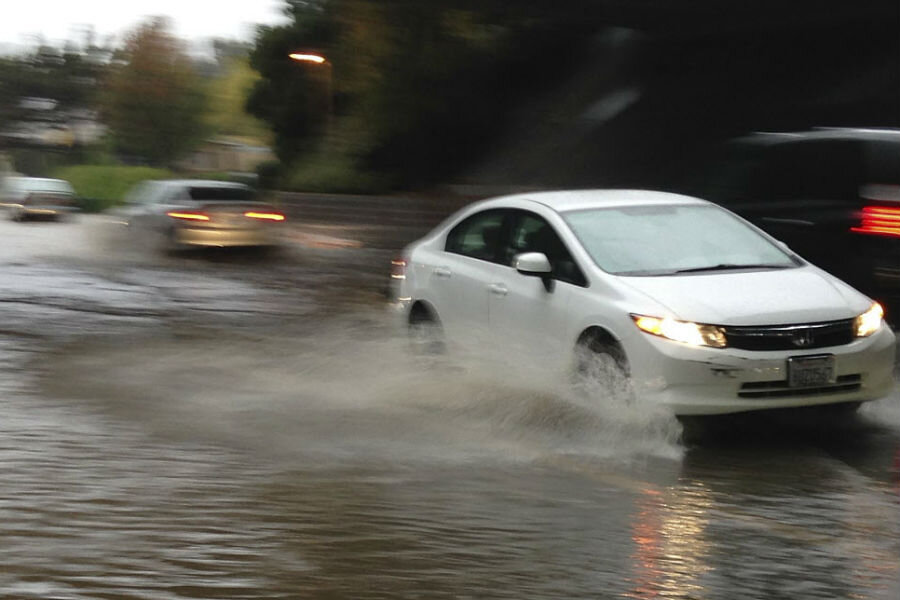As rain finally falls in California, are residents weary of conserving water?
Loading...
| Los Angeles
With pouring rain outside, street gutters are filled with gushing torrents of water, canyon roads are mimicking small brooks, and intersections look more like ponds. The once-standard winter scene has been absent for the past two years thanks to California’s historic drought.
Inside the corner coffee shop, the conversation is about water conservation fatigue during California’s prolonged, three-year drought. The State Water Resources Control Board released figures Tuesday showing residential customers didn't cutting back as much this past October as compared to last year. Officials worry that this week's heavy rains may lull residents already weary of water restrictions into a false sense of security.
“It’s only natural,” says Winnie Pierson, who moved to Sherman Oaks five years ago from the Midwest and is sipping a chai latte. “When the water is beating on the roof, you’re not as inclined to turn off the spigot when brushing your teeth.”
That’s just the attitude state officials are concerned about. However, just because California is seeing much needed storms, the drought is far from over. Not enough people are conserving enough water, they say, especially in southern California.
San Diego and Los Angeles saw only a 1.4 percent savings in October 2014, compared to 2013, a huge drop off from September’s figure of 7.5 percent savings over the year prior.
“We would have liked to have seen better,” Eric Oppenheimer, head of the Office of Research, Planning and Performance for the water board said in a statement. He mentioned “this notion of conservation fatigue. Just over time, the message is getting blurred a little bit, and people are falling back to their old ways.”
Overall, California residential customers did use 6.7 percent less water in October this year than last. However, that’s far less than the 10.3 percent year-to-year savings in September or 11.6 in August. Those figures are roughly half of Gov. Jerry Brown’s request of 20 percent earlier in the year.
“To be completely honest, I don’t have conservation fatigue because I haven’t been conserving enough as it is,” says Randy Cohen, a 30-something, single screenwriter. “But I don’t have a house or a lawn or a car, so I figured it wasn’t making that much difference.”
And not every southern Californian expressed weariness with cutting back on their water use.
“That’s not me,” says retiree Ellie MacIntyre. “My condo association is all over this issue. We’re all doing everything we can and are not tired of it at all.”
Building manager Jose Orenella says if you ask people kindly to conserve water, they do. If you don’t they don’t. He sends out written notices every month and has found people “very cooperative. They watch the news and know that without water, the farm workers just north of here in Camarillo are out of jobs.”
Shown the new figures, he just scratches his head, and says, “this is good information that I don’t think people realize. Frankly, I think they cut back on water use because of the cost.”
State media seem to be picking up on the angle that residents need to understand that one storm system – or even a few – do not end a drought.
“I have to credit the media for being all over this issue in a way that has really helped,” says Kitty Connolly, executive director of the Theodore Payne Foundation, which promotes the preservation of California landscapes, and habitats.
For example, the San Francisco Chronicle printed a 10-city comparison of per capita water use in the nine-county Bay Area for October. At the low end is Daly City at 43.5 and high end is Dublin/San Ramon at 70.6. The numbers partly reflect different living situations. Daly City has a moderate climate and small lot sizes. The statewide average is 109 gallons a day.
“When I see figures like that, it helps me stick to a regimen,” says Sherman Oaks homeowner Peter Wallace, a retired venture capitalist. "I used to leave the water on while brushing my teeth. Now I don’t.”





